
By Thea Aslanian, Energy Analyst
Introduction and Background
Across New England, state legislatures are rebalancing ambitious climate goals with rising concerns over energy affordability. Costs of living in the Northeast have risen 3% year-over-year as of June, with household energy costs rising almost 13%. In the first half of 2025, several states passed major reforms to their renewable energy programs, utility regulations, and energy departments. As the federal government sours on renewable energy, New England state lawmakers are rethinking and restructuring previous energy programs with an emphasis on costs.
Two of the most common vehicles for states to increase renewable adoption are by imposing a Renewable Energy Standard (RPS) and Net Metering/Net Energy Billing (NEB). A RPS is a state-level mandate that requires electricity providers to supply a percentage of their electricity from renewable sources, which is done by purchasing and retiring Renewable Energy Credits (RECs) from qualified projects. As federal incentives for new renewable projects are phased out (see “The OBBBA vs. the IRA: Crystalizing Energy Policy Changes), there is some concern that states will struggle to meet their RPS goals, which could in turn increase the costs of the program or require states to revisit these policies. NEB programs differ between states but essentially they offer retail rate compensation for small-scale renewable energy systems (usually solar) for excess electricity sent back to the grid. Critics of NEB argue that it shifts program costs onto non-participating ratepayers and the high rates offered results in over-incentivizing renewable energy projects. Recent energy legislation in the region has focused on amending these two programs.
Massachusetts
In Massachusetts, The Energy Affordability, Independence, and Innovation Act, filed May 13 by Governor Maura Healey, is still moving through the legislative process. One of the most consequential provisions would shift the authority to procure large-scale clean energy contracts from utilities to the state, which could accelerate procurement and potentially deliver better pricing. Other proposed changes include the repeal of a requirement that new nuclear facilities receive approval through a statewide referendum and a provision allowing gas utilities to own geothermal loops for individual customers.
The bill also proposes a phased reduction in net metering credit rates for new commercial solar projects interconnecting after January 1, 2026, with legacy projects transitioning to the new structure after 25 years. Another change to current state renewable programs would phase out the Alternative Portfolio Standard (which currently incentivizes thermal technologies like biofuel, ground and air source heat pumps, and combined heat and power) by 2028.
Maine
“An Act to Advance a Clean Energy Economy by Updating Renewable and Clean Resource Procurement Laws,” a Maine law signed in June, changes state RPS requirements starting in 2030. While Class 1A obligations previously remained at 40% after 2030, now they will increase by 1% per year and remain at 50% from 2040 onward (see Figure 1). This legislation also introduces a Class III requirement starting at 1% in 2031 and increasing to 10% in 2040 and beyond. A Class III, or clean, resource expands the former RPS qualified resource portfolio by including nuclear and larger hydropower projects. This new law codifies a state target of 100% clean electricity by 2040.
Figure 1- Previous and Current Maine Renewable Portfolio Standards, Competitive Energy Services, 2025
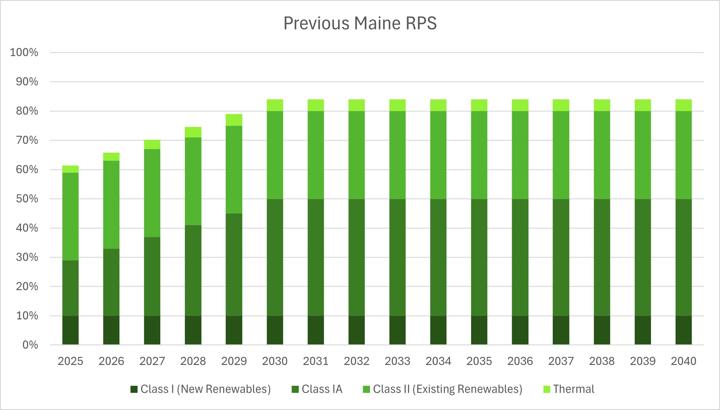
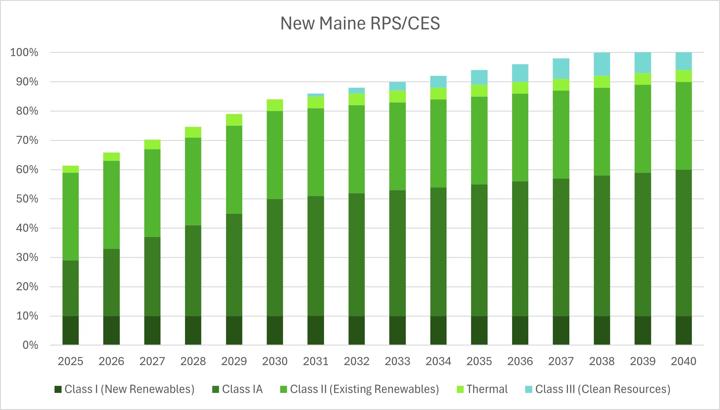
Shortly after increasing the Maine RPS, the state legislature passed “An Act to Reduce Costs and Increase Customer Protections for the State’s Net Energy Billing Program.” Beginning in 2026, new “front-of-meter” projects, standalone renewable developments connected directly to the grid, will no longer be eligible for Net Energy Billing (NEB), although a successor program is set to be designed by the Public Utilities Commission in the coming years. Impacts on existing NEB projects vary. Projects previously on a fixed, “Alternative” tariff rate will receive the same rates. However, projects that had been receiving floating credit rates based off standard offer and delivery rates will change to a reduced fixed rate starting in 2026, escalating at 2.25% each year. Finally, projects participating in the separate, kilowatt-hour crediting part of the NEB program will have to pay a new utility bill charge to help offset program costs. The retroactive changes are a significant blow to solar developers and broadcast uncertainty for future projects in the region. This bill comes as a compromise as the state has considered various cuts to the program to wrangle growing program costs in recent years, which are socialized by all Maine ratepayers.
To recover expenses and lost revenues from state policy initiatives such as NEB, utilities include a charge for “stranded costs” on customer bills. The issue of equitably allocating these costs is widely debated; the state is working toward solutions in alignment with electrification goals to avoid penalizing customers who pursue electrification measures and increase their electricity consumption. These charges have been restructured multiple times by the Public Utilities Commission, including in July. Stranded costs will be restructured again starting in October, following the passage of a bill to limit usage-based stranded cost charges and put most costs into fixed bill charges.
With state energy challenges growing more complex, Governor Mills recently signed an act to create the Maine Department of Energy Resources. This new cabinet-level department will address energy affordability and grid reliability, building on the work of the current Governor’s Energy Office. The department will also have the authority to procure clean energy from projects approved by the Maine Public Utilities Commission and is expected to formally launch later this year.
Connecticut
On July 1, Governor Lamont signed an energy bill designed to reduce ratepayer costs, reform renewable energy mandates, and improve utility oversight. “An Act Concerning Energy Affordability, Access and Accountability” saw bipartisan support from both the House and the Senate. Savings are projected at $800 million over three years.
The first state to do so in the region, the bill scales back the state’s Renewable Portfolio Standard (RPS) starting next year. Connecticut's Class I RPS requirement is dropping from 32% to 25% in 2026 and from 40% to 29% in 2030 (see Figure 2). The new legislation also excludes methane gas and new wood-burning biomass facilities from Class I Renewable Energy Credit (REC) qualification and imposes an annual municipal solar tax for new ground-mount systems over one megawatt. These changes were made with the hope of easing financial pressure on ratepayers, though weakening RPS targets may also slow the development of new solar and wind projects and send an uncertain signal to clean energy investors.
Figure 2 - Previous and Current Connecticut Renewable Portfolio Standards, Competitive Energy Services, 2025
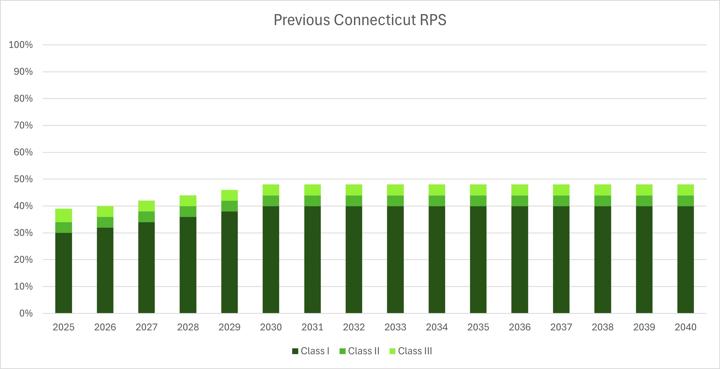
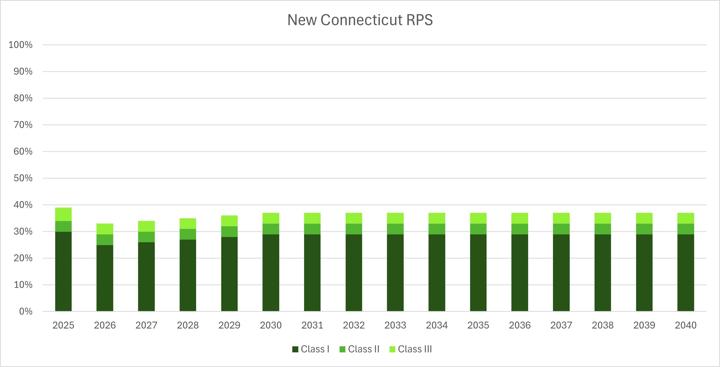
New Hampshire, Vermont, and Rhode Island
New Hampshire has historically been less inclined than other New England States to prioritize and incentivize renewable energy development. While other states in the region have RPS goals of up to 100% renewable electricity, New Hampshire’s obligation capped this year at 25%. When New Hampshire’s RPS program was established in 2007, the state created a Renewable Energy Fund made up of Alternative Compliance Payments from electric suppliers who failed to meet their RPS obligations. The state recently passed a budget bill that redirects approximately $15 million from its Renewable Energy Fund into its General Fund. The funding reallocation is a disappointment for clean energy advocates who had expected the assets to go toward extending a pilot program developing municipal solar projects.
Rhode Island and Vermont saw fewer notable shifts in energy policy in recent months. While broader affordability debates were less prominent than in neighboring states, Vermont remained active on climate accountability, defending a first-in-the-nation law requiring fossil fuel companies to pay for climate damages—a policy now being challenged in federal court. Rhode Island aims to reach 100% clean energy by 2033 under its Renewable Energy Standards, positioning it to become the first in the region to achieve this milestone. Governor McKee recently announced an additional $10 million toward the state’s heat pump incentive program to prioritize support for moderate- to low-income households. These efforts demonstrate a continued commitment to climate action in both states.
Figure 3 - Current New England Renewable Portfolio Standards, Competitive Energy Services, 2025
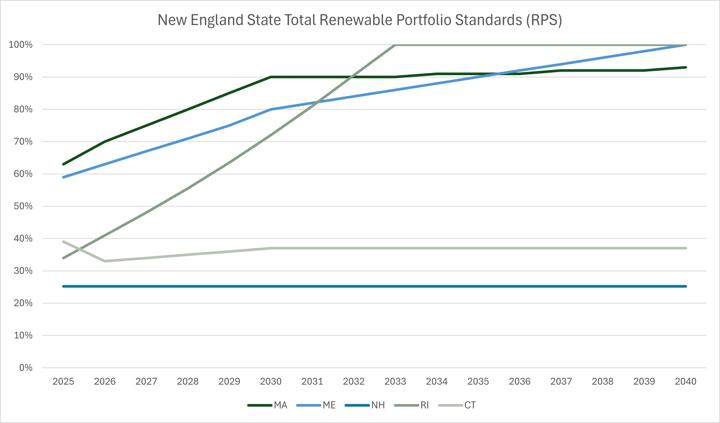
Conclusion
While Maine increased clean energy goals with expanded RPS targets and worked to rein in energy prices by lowering NEB rates, Connecticut and New Hampshire prioritized concerns around costs. Massachusetts is reviewing a sweeping energy bill that aims to centralize procurement and reform incentive programs. Rhode Island and Vermont saw more incremental changes in recent months, with continued emphasis on funding climate goals. These legislative changes demonstrate a transitional period for energy policy in the region, focusing less on rapid climate progress and more on affordability for ratepayers, program refinement, and centralized clean energy procurement.
Photo by Ken Howard
